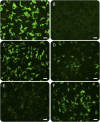IgLON5 antibody: Neurological accompaniments and outcomes in 20 patients
- PMID: 28761904
- PMCID: PMC5515599
- DOI: 10.1212/NXI.0000000000000385
IgLON5 antibody: Neurological accompaniments and outcomes in 20 patients
Abstract
Objective: To describe the phenotypes, treatment response, and outcome of IgLON5 autoimmunity.
Methods: Archived serum and CSF specimens from 367 patients known to harbor unclassified antibodies which stained neural synapses diffusely (mimicking amphiphysin-IgG) were reevaluated by indirect immunofluorescence assay (IFA) using a composite of mouse tissues and recombinant IgLON5-transfected cell-based assay (CBA, Euroimmun).
Results: Available specimens (serum, 25; CSF, 9) from 26/367 patients (7%) had identical IFA appearance and robust IgLON5 CBA positivity. Clinical information was available for 20/26 patients; 13 were women. Median disease-onset age was 62 years (range, 46-75 years). Most patients had insidious onset and progression of neurological symptoms affecting movement and sleep predominantly. Sleep disorders were sleep-disordered breathing (11) and parasomnias (3). Brainstem disorders were gait instability (14), dysphagia (10), abnormal eye movements (7), respiratory dysfunction (6), ataxia (5), craniocervical dystonia (3), and dysarthria (3). Findings compatible with hyperexcitability included myoclonus (3), cramps (3), fasciculations (2), and exaggerated startle (2). Neuropsychiatric disorders included cognitive dysfunction (6), psychiatric symptoms (5), and seizures (1). Dysautonomia, in 9, affected bladder function (7), gastrointestinal motility (3), thermoregulation (3), and orthostatic tolerance (1). Just 2 patients had coexisting autoimmune disease. Brain MRI findings were nonspecific and CSF was noninflammatory in all tested. Seven of 9 immunotherapy-treated patients improved: 6 of those 7 were stable at last follow-up. Three untreated patients died. Each IgLON5-IgG subclass (1-4) was readily detectable in ≥80% of specimens using CBA.
Conclusions: IgLON5-IgG is diagnostic of a potentially treatable neurological disorder, where autoimmune clues are otherwise lacking.
Figures


References
-
- McKeon A, Pittock SJ. Paraneoplastic encephalomyelopathies: pathology and mechanisms. Acta Neuropathol 2011;122:381–400. - PubMed
-
- Hutchinson M, Waters P, McHugh J, et al. . Progressive encephalomyelitis, rigidity, and myoclonus: a novel glycine receptor antibody. Neurology 2008;71:1291–1292. - PubMed
LinkOut - more resources
Full Text Sources
Other Literature Sources
